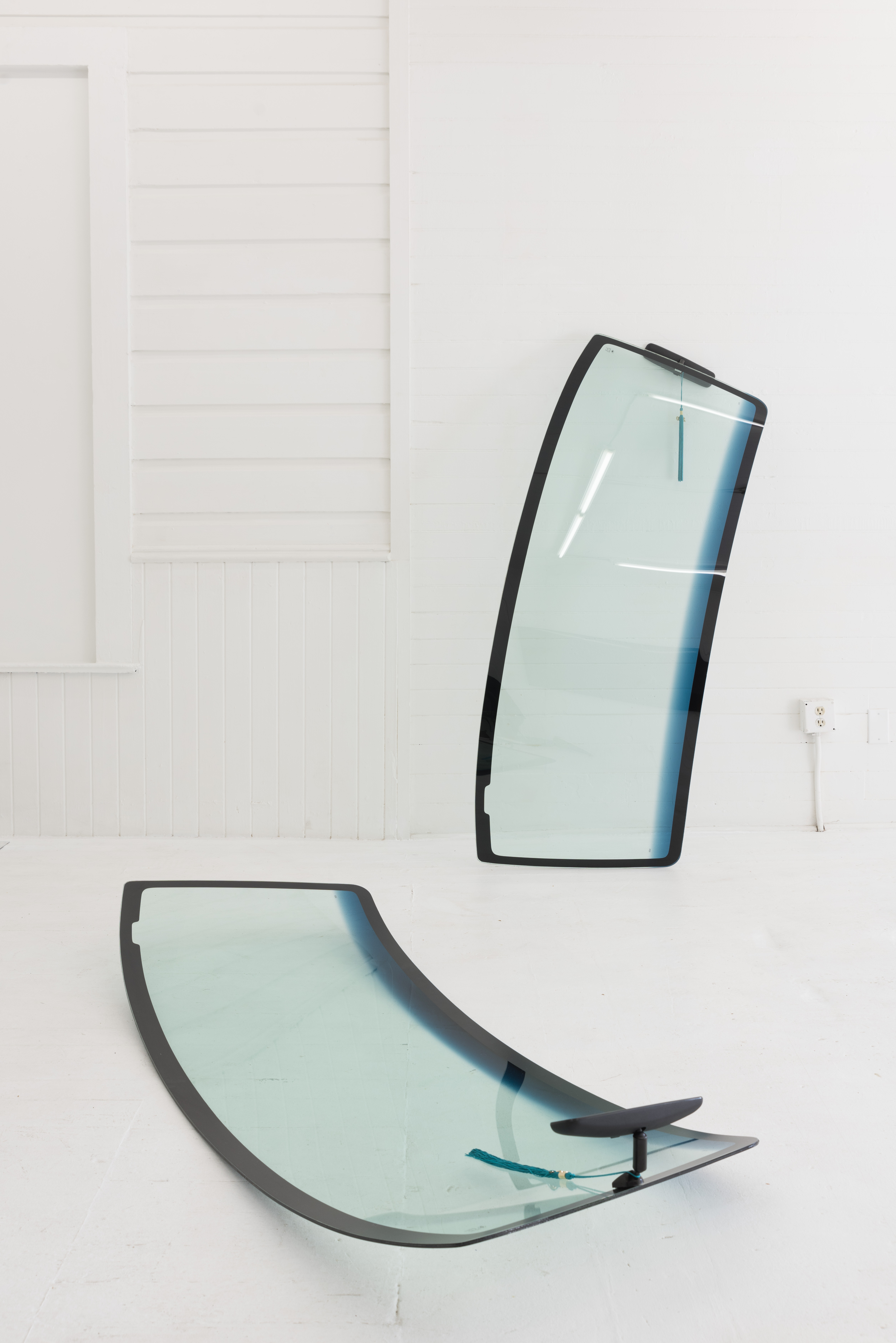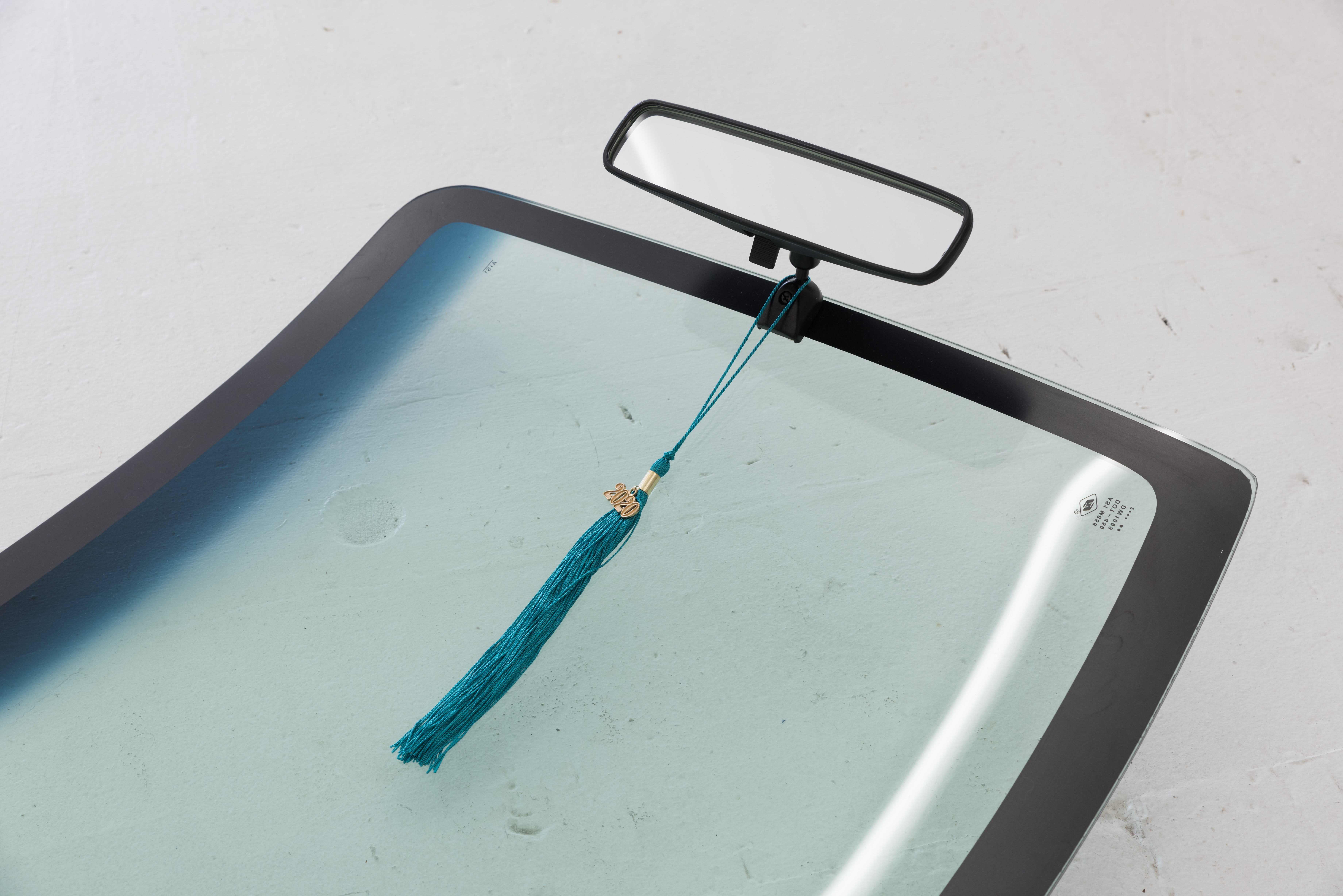







 Rearview Unity, 2019
Rearview Unity, 2019Ford Ranger mirrors, graduation tassels
25 x 15 1/2 x 4 inches
 The Way Forward (ranger structures), 2019
The Way Forward (ranger structures), 2019digital video, sound
TRT: 36:00
&
The Way Forward (dub overspray), 2019
digital video, sound
TRT: 17:00
 The Way Forward (ranger structures), 2019
The Way Forward (ranger structures), 2019archival inkjet print
31 1/2 x 42 inches
edition of 2 + I AP
 Rearview Celebration, 2019
Rearview Celebration, 2019Ford Ranger mirror,
graduation tassels
10 x 15 1/2 x 4 inches
 Ranger Arc (1), 2019
Ranger Arc (1), 2019Ford Ranger mirror,
Ford Ranger windshield,
graduation tassel
23 x 9 x 66 inches
&
Ranger Arc (3), 2019
Ford Ranger mirror,
Ford Ranger windshield,
graduation tassel
23 x 9 x 66 inches

Ranger Arc (3), 2019
detail view
 The Way Forward (dub overspray), 2019
The Way Forward (dub overspray), 2019archival inkjet print
31 1/2 x 42 inches
edition of 2 + I AP
Jesse Sugarmann
The Way Forward
September 8–October 12, 2019
Opening reception:
Sunday, September 8th, 11am–1pm
In 2005, Ford Motor Corporation announced The Way Forward, an internal restructuring plan designed to shield the corporation from the growing pressures of globalized manufacturing and diminishing resources. The Way Forward was a proactive and self-destructive approach, canceling several vehicle models and eliminating salaried positions at all levels. A combination of strategy and sacrifice, the Way Forward was largely successful – Ford was the only wing of the Big Three to avoid bankruptcy during the 2008 federal bailout of the automotive industry.
In The Way Forward, Jesse Sugarmann interprets Ford Motor Corporation’s systems of restructuring and sacrifice as sculptural directives. Using video and photography to document his automotive performances, Sugarmann presents sculptural actions designed to combine Ford’s boardroom logic with individual actions of ritual and sacrifice. The resulting work is a mesh of collision and ceremony, a presentation of new strategies for navigating our contemporary crises.
Jesse Sugarmann is an interdisciplinary artist who engages the automotive industry as a manufacturer of human identity, accessing automotive history as an index of both cultural progress and social development. He has exhibited work internationally, including at the Banff Center, Canada; Filmbase, Ireland; the Getty Institute, Los Angeles; High Desert Test Sites, Joshua Tree; the Kellen Gallery at Parsons School of Design, New York; the Knockdown Center, New York; Michael Strogoff, Marfa; el Museo de Arte Moderno de Santander, Spain; el Museo Tamayo, Mexico City; the Portland Institute for Contemporary Art, Oregon; les Recontres Internationales, Paris and Berlin; the SMFA Grossman Gallery, Boston; Southern Exposure, San Francisco; and the Toledo Museum of Art, Ohio. Sugarmann’s work has been written about in publications including ArtForum,Art F City, Art Papers, the Atlantic, the Boston Phoenix, Frieze magazine, the Huffington Post, Hyperallergic, the New York Times, the Seattle Times and Sports Illustrated. Jesse Sugarmann lives and works in Bakersfield, California.
The Way Forward
September 8–October 12, 2019
Opening reception:
Sunday, September 8th, 11am–1pm
In 2005, Ford Motor Corporation announced The Way Forward, an internal restructuring plan designed to shield the corporation from the growing pressures of globalized manufacturing and diminishing resources. The Way Forward was a proactive and self-destructive approach, canceling several vehicle models and eliminating salaried positions at all levels. A combination of strategy and sacrifice, the Way Forward was largely successful – Ford was the only wing of the Big Three to avoid bankruptcy during the 2008 federal bailout of the automotive industry.
In The Way Forward, Jesse Sugarmann interprets Ford Motor Corporation’s systems of restructuring and sacrifice as sculptural directives. Using video and photography to document his automotive performances, Sugarmann presents sculptural actions designed to combine Ford’s boardroom logic with individual actions of ritual and sacrifice. The resulting work is a mesh of collision and ceremony, a presentation of new strategies for navigating our contemporary crises.
Jesse Sugarmann is an interdisciplinary artist who engages the automotive industry as a manufacturer of human identity, accessing automotive history as an index of both cultural progress and social development. He has exhibited work internationally, including at the Banff Center, Canada; Filmbase, Ireland; the Getty Institute, Los Angeles; High Desert Test Sites, Joshua Tree; the Kellen Gallery at Parsons School of Design, New York; the Knockdown Center, New York; Michael Strogoff, Marfa; el Museo de Arte Moderno de Santander, Spain; el Museo Tamayo, Mexico City; the Portland Institute for Contemporary Art, Oregon; les Recontres Internationales, Paris and Berlin; the SMFA Grossman Gallery, Boston; Southern Exposure, San Francisco; and the Toledo Museum of Art, Ohio. Sugarmann’s work has been written about in publications including ArtForum,Art F City, Art Papers, the Atlantic, the Boston Phoenix, Frieze magazine, the Huffington Post, Hyperallergic, the New York Times, the Seattle Times and Sports Illustrated. Jesse Sugarmann lives and works in Bakersfield, California.